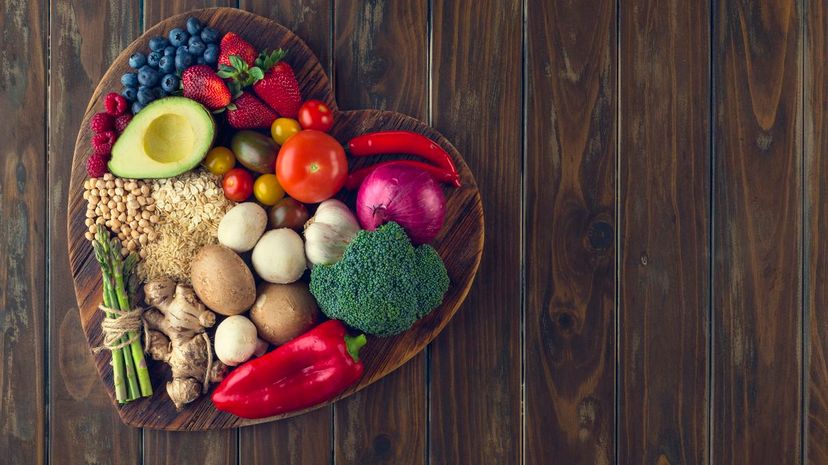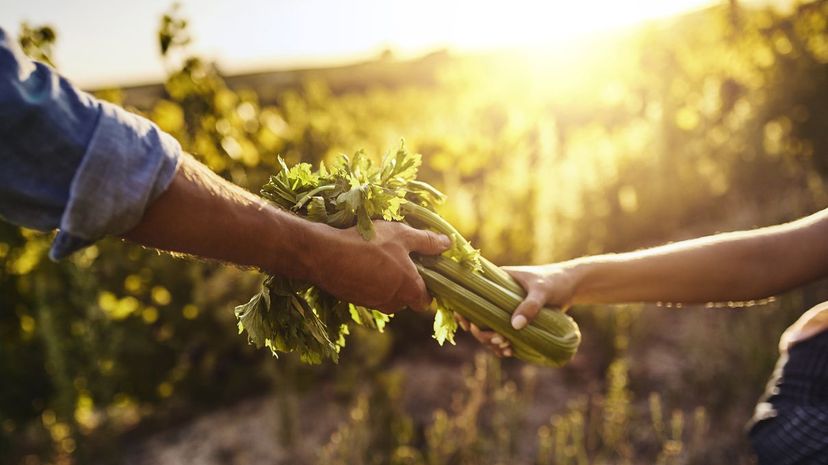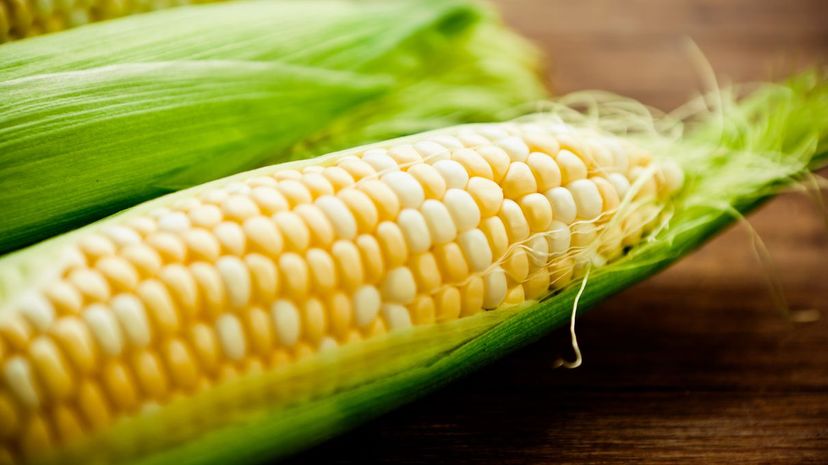
About This Quiz
Is it true? We herb you have a thing for vegetables! Well, now it's thyme to prove it. We're taking you down the vegetable aisle to find out if you have what it takes to beet the odds and crush this fresh challenge.Â
On the right there's parsley, or wait, is that cilantro? And on the left there's endive. Or is that radicchio? If you can tell your yams from your sweet potatoes and your zucchini from your summer squash (that's the yellow one, right?), then you could be well on your way to slicing your way through this quiz! Get ready to fennel your inner green thumb and your inner pharmacist too!Â
Huh? Did you say pharmacist? Why, yes we did! Since ancient times, people around the world have "prescribed" veggies as a treatment for various ailments. Packed with nutrients, vitamins and minerals, vegetables help protect our bodies so we romaine healthy. Got nausea or arthritis? Try some ginger. Want to promote eye health? No, it's not just a myth; eat carrots! But first, let's see if you can correctly identify these healthy vegetables.
Come on now, don't be a couch potato or you might be in for a root awakening. Good luck and remember, you were mint to ace this quiz!

It's not just a myth, eating carrots is, in fact, good for your eyes. When we eat carrots, our bodies convert the beta carotene into vitamin A which plays an important role in maintaining healthy eyesight. Other veggies rich in beta-carotene include sweet potatoes, red and yellow peppers and squash.

So you think farmers plant four different kinds of peppers? Wrong! Yellow, orange and red peppers are just green peppers that have been left on the vine longer. Having spent the most time ripening, red peppers win the award for most nutritious of them all.

Next time you enjoy a side of broccoli, you can thank the central coast of California. Did you know that 40% of the broccoli crop in the United States comes from Monterey County? With the longest growing season there, broccoli is available nearly all year long.
Advertisement

While Oceana County, Michigan, may call itself the asparagus capital of the world, China wins the prize for most production. Peru, on the other hand, is the world's leading exporter of the crop. A perennial flowering plant, asparagus takes three years to go from seedling to its first harvest.

Are you looking to celebrate the existence of the sweet potato? Mark your calendar, because February is National Sweet Potato Month! You may even consider moving to North Carolina where the official state vegetable is the sweet potato. Wherever you enjoy this nutritious potato, remember it is not a yam.

When looking for a potassium boost, many people flock to the banana. Next time, try a cup of butternut squash! While bananas contain 422 milligrams of potassium, butternut squash provides 582. It is also the most popular of the winter squash variety.
Advertisement

Brussels sprouts may look like baby cabbages but they are not a cabbage. Instead, Brussels sprouts grow on a long and thick stalk. While they are most often sold in small netted bags, some specialty grocery stores may sell the actual stalk. Keep your eyes out next time you're in the produce section; you might just spot one.

Anyone who knows arugula would describe it as having a peppery and nutty flavor. A big component in Italian cuisine, arugula is used in salads, as a leafy green in sandwiches and as a garnish on meals, including a prosciutto and fig pizza fresh out of the oven.

Potatoes are a significant component of diets around the world. First cultivated by the Incas, potatoes made their way to Europe with the return of the Spanish Conquistadors in the 1500s. Today, the average American eats 110 pounds of potatoes every year, and Europeans consume double that amount!
Advertisement

Before pharmacies, there was celery. First cultivated in the Mediterranean 3,000 years ago, celery was often used to treat medical conditions such as hypertension, arthritis and insomnia. A vegetable of diverse benefits, Ancient Romans even used it as an aphrodisiac!

While many people think broccoli and cauliflower are the same, this is not the case. While it's true they are both in the Brassicaceae family, they belong to different cultivar groups. Broccoli is categorized in the Italica group, and cauliflower is among the Botrytis group.

Did you know that eggplant is technically, or should we say, botanically, a berry? Unlike other berries, however, it is not so sweet. Eggplants, which grow wild in India, are a typical main dish of Mediterranean cuisines often paired with ground meat and sauce.
Advertisement

Whether you eat them in your salad, pureed in a dip, or as a side dish, if you're in the United States, your artichokes came from California. This state produces 100% of the American artichoke crop. Elsewhere around the world, artichokes are grown in Italy, Spain and France.

Would you like to avoid crying while chopping an onion? Experts suggest the following: cut the root end last, cut it while the onion is cold, or cut it while running the onion under cold water. We digress on the last suggestion, but you could give it a try.

Corn is produced everywhere around the world except for Antarctica. It is not only eaten as is, but it is also processed and used to make food and drinks, including cereals, salad dressings, cooking oil and soft drinks. Many juices are also sweetened by corn.
Advertisement

With more than 10,000 varieties of mushrooms out there, white, portabello, cremini and shiitake are the most recognized by consumers. Made up of 90% water, mushrooms are a great source of protein and potassium, particularly for vegetarians who enjoy their "meaty" texture.

The ideal parsnip is between 6 to 10 inches long and harvests six months after sowing. It is also a biennial plant, producing a crop for two years. Parsnips can be enjoyed raw in a salad, or as part of a hearty soup or stew.

What's a chef's trick for tempering down the bitterness of radicchio? Use it sparingly and dress it appropriately. Radicchio is often mixed with other salad greens and paired with a citrus vinaigrette which helps to cut its bitter flavor.
Advertisement

Whether doused in mayonnaise or drizzled with a light vinaigrette, the star of coleslaw is cabbage. While some Asian slaws are made with purple cabbage, what you find at a typical summer barbecue is comprised of green cabbage, also known as Napa cabbage.

Don't be surprised if your child comes home from school with radish seedlings. Radishes serve as the perfect gardening experience for children because these hardy little vegetables are fast-growing. In fact, radishes are a member of the Raphanus genus which is Greek for "quickly appearing."

Would you like to know why strawberries and rhubarb pair so well together? Rhubarb has a bitter taste that mellows the sweetness of strawberries. Baker beware though, rhubarb's leaves are poisonous. Be sure to use only the stalks and discard the leaves immediately.
Advertisement

They come fresh, frozen, canned, split, and you can even douse them in wasabi! Peas have been around for thousands of years. They originated in the Middle East and are grown all over the world today. The top green pea producing countries include India, France, Egypt and the United States.

As a starchy root vegetable, you might think that turnips are related to potatoes, but they are a member of the mustard family along with rutabaga and radishes. While they are traditionally served warm with haggis in the United Kingdom, many Middle Eastern countries pickle them and serve them cold.

Not only do beets bring nutrients into your body, but they also take toxins out of your body. With copious amounts of folate, vitamins A and K, beets also contain a compound known as betalain which helps flush out toxins. Aside from its potential to stain your clothes, this is a win-win vegetable.
Advertisement

Ginger in its root form can be found in the vegetable aisle, but elsewhere around the grocery store, you'll find it pickled, powdered, candied and dried. No matter how you slice it or eat it, ginger is known for its anti-inflammatory and anti-nausea effects.

Aside from being a delicious and crunchy addition to your salad, cucumbers offer a variety of other uses. These include warding off grubs in your garden, to preventing a hangover, to clearing up your foggy bathroom mirror. Whatever the need, be sure to eat some too; they contain lots of vitamins.

Of all the different types of squash in the world, acorn squash has a claim to fame. It contains the best nutritional value of all. Just one cup of cooked acorn squash provides more potassium than two bananas and loads of folate, calcium and magnesium.
Advertisement

Grown around the world, and mainly in China, did you know that rutabaga is a cross between cabbage and turnip? In North America, it is known as rutabaga, but in Scotland, these vegetables are called neeps. Neeps and haggis, anyone?

Discovered by a European botanist in 1554, kohlrabi gets its name from the combination of two German words: cabbage (kohl) and turnip (rabi). What's the best way to eat kohlrabi? Chefs around the world agree it can be roasted, steamed, fried, pureed or enjoyed raw.

While botanically they classify as a fruit, tomatoes are more often consumed as a vegetable. They are eaten raw in salads, cooked into side dishes or pureed as sauces. Greeks and other Mediterranean cultures even stuff them with meat as a main course!
Advertisement

The "eat all" name given to sugar snap peas refers to the fact that you can also eat their pods. While the pods of snap peas, snow peas and edamame can be eaten, garden peas need to be removed from their pods before eating.

Sunchokes may look like large pieces of ginger, but they are a cross between artichokes and potatoes. Their flavor is nutty and savory, and they can be eaten raw or cooked. When preparing them, remember that they are similar to apples and potatoes in that air exposure will oxidize them. Toss in lemon!

There are two main types of parsley found in the grocery store: curly leaf and flat leaf. Used most often in European and Middle Eastern cuisine, parsley is a biennial plant. It is cultivated in the sun in moist soil but try to shield it from unwanted predators like butterflies and birds.
Advertisement

Bok choy is also known as Chinese cabbage and is the younger sibling to Napa cabbage. Grown in cooler seasons, like spring and fall, bok choy is produced mainly in China with some harvests in California and Canada. Though it may look like cooked celery, bok choy tastes like cabbage.

Chives are a member of the allium family of vegetables and herbs. Its relatives include scallions, onions and garlic. From a breakfast omelette to a bowl of ramen, chives not only serve as a garnish, they also offer a burst of flavor to many dishes.

Did you know that spinach is native to modern-day Iran? As a member of the amaranth family, it can be eaten fresh or cooked. In order for your body to absorb the high iron content of spinach, be sure to eat foods that are high in vitamin C with it.
Advertisement

Thought sprouts are high in vitamin K and low in calories, they come with a contamination warning. Sprouts are grown in warm, moist climates which are a perfect breeding ground for bacteria like salmonella and E.coli. Sprout lovers are encouraged to wash and cook their sprouts for best results.

Anyone who has tasted fennel will tell you it tastes like licorice. This is because both fennel and licorice contain anethole, a naturally aromatic organic compound. Unlike the candy, fennel is known for its medicinal properties that help lower cholesterol and reduce the risk of heart disease.

Did you know that kale is actually a leaf cabbage? It just doesn't grow a head! Kale is typically planted in the spring and harvests all summer long. In the United States, the top kale producers include California, Georgia and New Jersey.
Advertisement

Wider and milder than serrano peppers, jalapeños are typically 3 inches long and about 1 inch in diameter. They are cultivated around the world, but did you know that jalapeños make up 30% of Mexico's chili production? Mexico currently has about 100,000 acres of land dedicated to growing jalapeños.